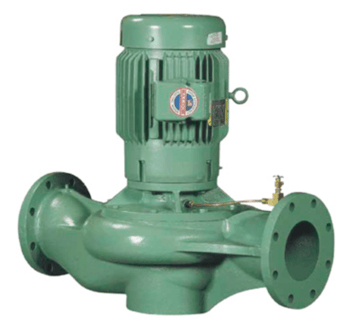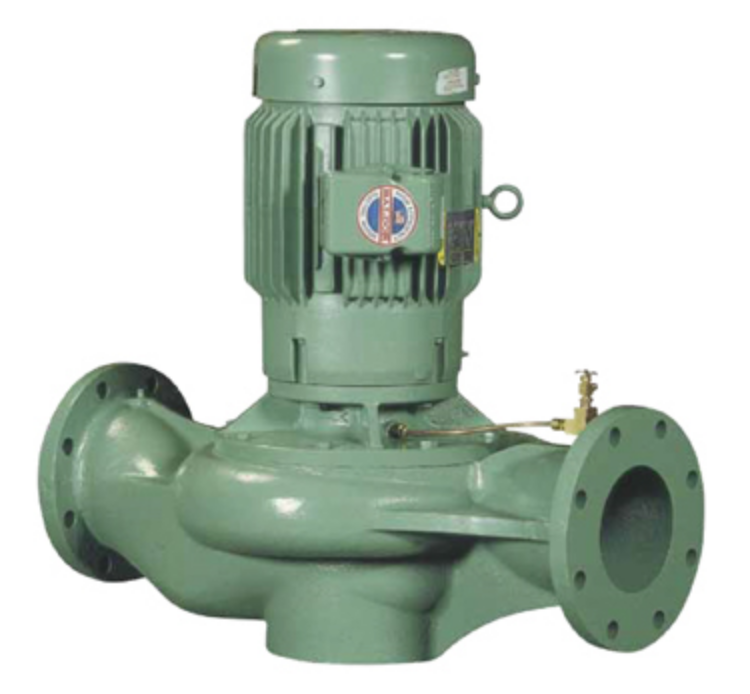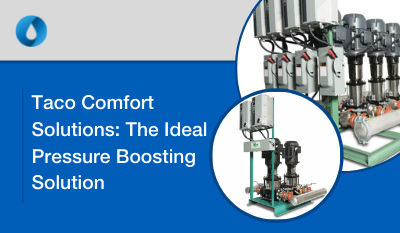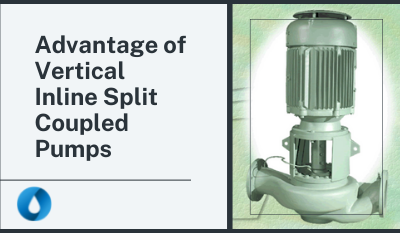 The vertical inline close-coupled (VICC) pump operates internally on the same principle as end suction pumps. The big difference is that physically, the suction includes a longer path to the eye of the impeller, allowing both the suction and discharge connections to be inline with the piping. The VICC pump shares with its end suction cousin the pros and cons of having the impeller close-coupled to the motor shaft, but having a vertical shaft configuration does have some additional advantages.
The vertical inline close-coupled (VICC) pump operates internally on the same principle as end suction pumps. The big difference is that physically, the suction includes a longer path to the eye of the impeller, allowing both the suction and discharge connections to be inline with the piping. The VICC pump shares with its end suction cousin the pros and cons of having the impeller close-coupled to the motor shaft, but having a vertical shaft configuration does have some additional advantages.
Here are six reasons you might consider a vertical inline close-coupled pump to an end suction pump:
- No shaft alignment required: Like the CCES pump, the VICC doesn’t have a coupling to align. The impeller is keyed directly to the motor shaft, eliminating the coupling, additional bearing assembly, and the need for professional shaft alignment.
- Naturally less noise and vibration: The vertical shaft configuration (perpendicular to the ground) is inherently balanced. Gravity is never pulling with or against the direction of rotation. Therefore, any imbalance that may be present will remain much less pronounced than in an end suction pump.
- Floor space savings: VICC pumps may often require less floor space than BMES pumps with the motor and its service clearance located above the volute (wet end) of the pump. Also, smaller VICC pumps may be practically installed high above the floor. Again, just watch your service clearance.
- Additional piping flexibility: Due to the inlet configuration of a VICC pump, a suction diffuser or 5-pipe diameters of straight pipe on the suction is not required as with end suction pumps. This could come in handy in a tight space. Also, VICC pumps with 15-hp and smaller motors may optionally be installed with the shaft oriented in the horizontal position.
- No base to grout: With base mounted pumps, we’ve learned that the base must be grouted to reduce potential vibration and noise problems. And, it’s just one of the things commonly missed during installation. Since the VICC pump has no base, installation in simplified and cost is reduced.
- Initial cost savings: In most cases, a VICC pump that does the same GPM and head performance as a base mounted end suction pump will cost less up front. Factor in no alignment required, no base to grout, no suction diffuser or straight pipe required, and less floor space and the overall installed cost of a VICC pump will beat a BMES pump nearly every time.
Naturally, there are some other considerations to keep in mind when looking at VICC pumps.
- They typically have a higher NPSHr than end suction pumps.
- The motor and the impeller must be pulled from volute to service the mechanical seal, which may be challenging for motors larger than 25hp.
- VICC pumps may require more vertical clearance for installation and maintenance than end suction pumps.
- Air may be more easily trapped in volute than with an end suction pump.
As with all pumps, it’s important to base your final decisions on your specific requirements along with the benefits and limitations of each pump type. Consulting with a manufacturer’s rep can help you make good decisions for your applications.
But, we’re not done yet with our pump series! There is still one more configuration to cover in this particular blog series, and it may be the very best one for your application.
Author's note: This post has been updated from the original, posted in 2016.





.png)




Submit a Comment